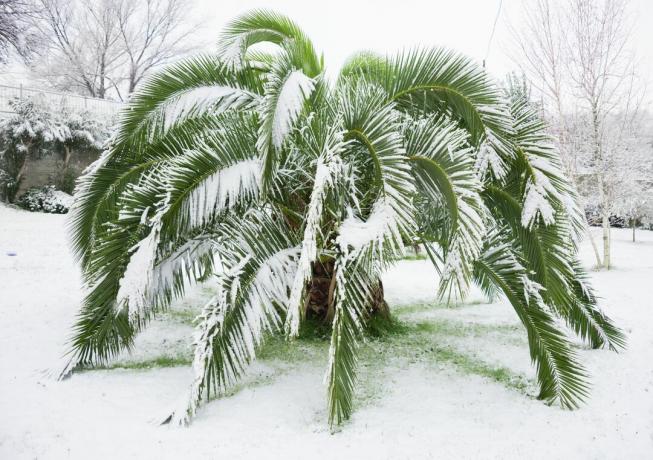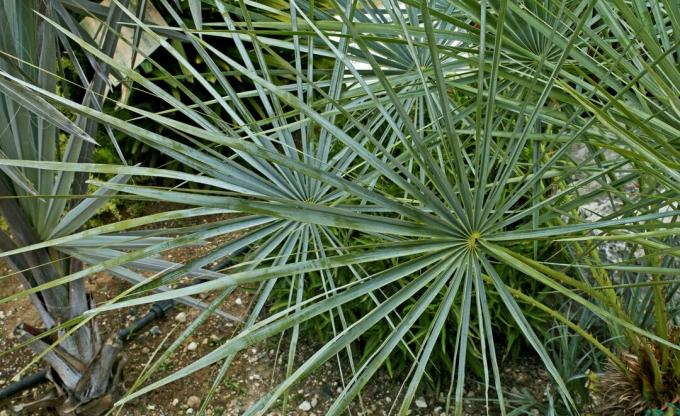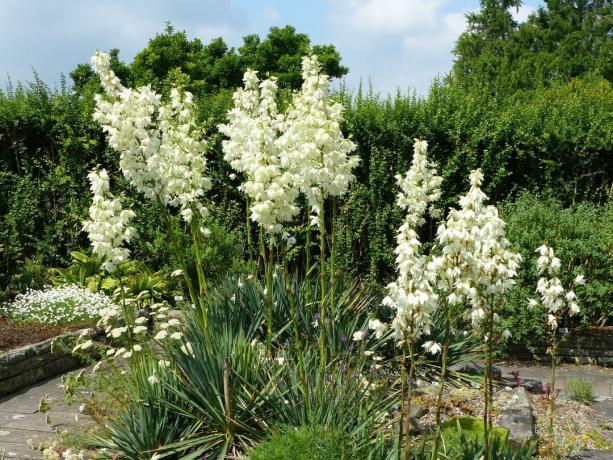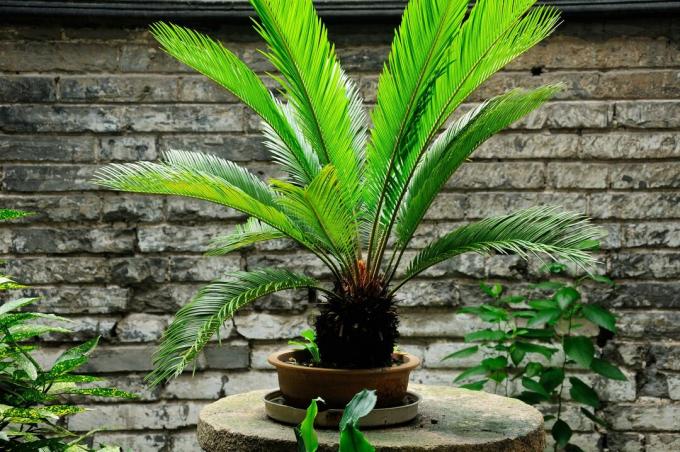Palm trees are the epitome of tropical vacation and warmth. But are there also hardy palm trees that survive the winter here?

Palm trees (Arecaceae) bring summer holiday feelings into the living room and even into your own garden. The exotic plants look most beautiful with their lush fronds or long, pointed leaves. Upon closer inspection, it's hard to find a favorite among the wide rows of palm trees. However, if you are looking for a specimen that should also spend the winter in the garden, it is worth taking a close look. Because not all palm trees are equally hardy. We have put together for you which robust representatives of the palm family can remain in the garden in winter and what temperatures they can withstand.
contents
-
Hardy Palms: 5 Suitable Palm Species
- Blue Dwarf Palm (Chamaerops humilis)
- Canary Date Palm (Phoenix canariensis)
- Chinese hemp palm (Trachycarpus fortunei; formerly: Chamaerops excelsa)
- Blue Needle Palm (Trithrinax campestris)
- Yucca (yucca)
-
Overwinter hardy palms
- Preparing hardy palm trees for winter
- Hardy palm trees after winter
Hardy Palms: 5 Suitable Palm Species
With certain types you can also bring Mediterranean flair into your own areas. The species listed below may be of interest to you if you have a tropical vibe want to produce and at the same time use plants that only need special protection in very severe winters require:
Blue dwarf palm (Chamaerops humilis)
The Blue Dwarf Palm is a hardy and low-maintenance plant with beautiful silver-blue leaves. Their original home is the Atlas Mountains in Morocco. It is considered to be very frost-resistant and can withstand temperatures down to -10 °C for a short time without damage. With suitable winter protection, the blue dwarf palm can also be overwintered in the garden without any problems.

Canary Date Palm (phoenix canariensis)
The robust palm tree with the spreading fronds reaches heights of up to 15 meters in its natural environment, but remains significantly smaller in pot culture. It forms fruits from February to June, which, in contrast to those of the real date palm, are not edible. If you want to be on the safe side with the Canary date palm, it is better not to rely on a particularly mild winter. You are well advised to place them in a warm (5 to 10 °C is ideal) winter quarters when the first few days fall below freezing. Real winter hardiness looks different.
Chinese hemp palm (Trachycarpus fortunei; former: Chamaerops excelsa)
The hemp palm is characterized by its strong, fan-like fronds. It reaches heights of up to four meters and produces green-yellow flowers from April to June. The Chinese hemp palm also survives the cold season outdoors in milder regions. However, the right location and suitable protective measures from -10 °C are crucial for successful hibernation.

Blue Needle Palm (Trithrinax campestris)
The blue needle palm forms hard, blue-grey leaves with thorny tips. It grows very upright and reaches heights of up to seven meters. This pretty palm originally comes from the dry forests of Argentina. Larger plants can therefore tolerate temperatures down to -15 °C, but in our latitudes they need suitable moisture protection.
yucca (Yucca)
In the yucca it is a genus that includes several popular species that brave the freezing temperatures. It is characterized by its beautiful lily-like flowers and palm-like tuft. The rather low-growing palm only reaches heights of about two meters. The individual varieties react very differently to low temperatures. There are frost-hardy yuccas that can be cultivated outdoors, but they don't tolerate prolonged wet conditions very well.

Overwinter hardy palms
Winter protection for palm trees offers various options for protecting the important parts of the plant. A distinction can be made between preventive measures, which take place before the onset of winter, and follow-up measures, which take place after winter.
Preparing hardy palm trees for winter
Before frosty temperatures arise, you can support the palm tree in various ways with regard to its winter hardiness in order to avoid frostbite:
- Place free-standing tubs in a sheltered location (eg. B. on a house wall) to reduce the influence of the weather
- Wrap tubs in a burlap sack and cover the soil with bark mulch, straw or fleece to provide further protection against frost
- In severe winters, wrap the trunk and leaves with fleece (tip: use light-colored fleece because it lets more light through)

Hardy palm trees after winter
As soon as the sub-zero temperatures are over, the palm trees can gradually be accustomed to normal conditions again. The following must be observed here:
- First of all, only put the palm tree in the sun for a few hours, otherwise sunburn can occur on the leaves
- Some long-term fertilizer is sufficient for palm trees and provides sufficient nutrients for a good start to the new garden year
- Remove brown, dried leaves as they are no longer needed as winter protection
If you have selected a robust palm species and follow the winter tips, it should not be a problem at all to get the tropical plants through the winter.
Here you can also find out how palm trees are properly fertilized.



